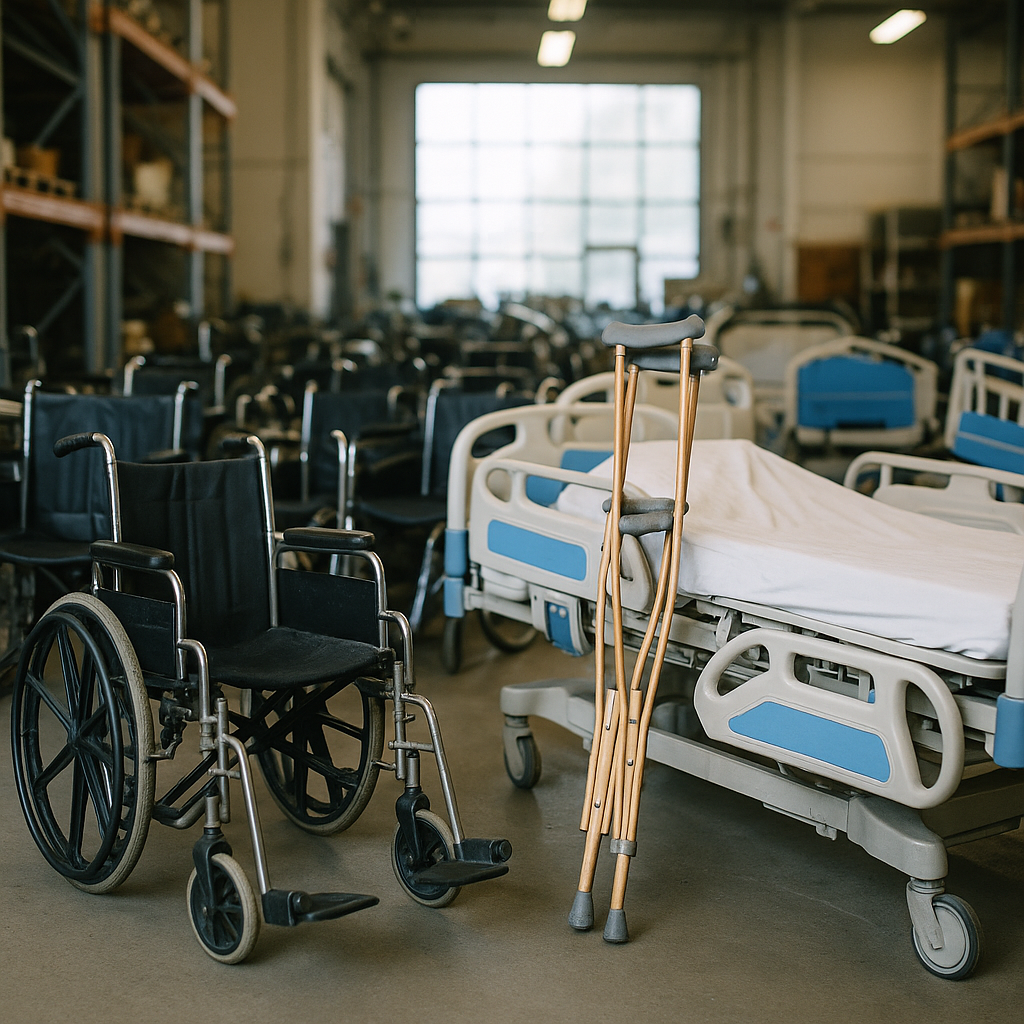5901 Botham Jean Blvd, Dallas, TX 75215
How to Recycle Medical Equipment Responsibly: A Guide for Hospitals and Clinics
August 19, 2025Medical equipment recycling involves safely disposing of unused or obsolete medical devices in an environmentally responsible way. From MRI machines and CT scanners to glucose monitors and surgical instruments, healthcare facilities generate a significant amount of equipment that requires proper handling at the end of its life.
This sustainable practice addresses a growing challenge in the healthcare industry. Medical equipment can quickly accumulate in hospitals and clinics when it becomes outdated or no longer meets facility needs. Instead of improper disposal or indefinite storage, recycling offers a secure and eco-friendly alternative that benefits both healthcare providers and the environment.
The recycling process includes several crucial steps: collecting unwanted equipment, securely wiping data to protect patient information, dismantling components, and recovering valuable materials like metals and plastics. This comprehensive approach helps prevent waste, reduces harmful emissions associated with manufacturing new equipment, and ensures compliance with environmental regulations and data security standards.
What Types of Medical Equipment Can Be Recycled?

The healthcare industry utilizes a wide range of equipment that can be recycled when no longer needed. Most medical devices, regardless of size or complexity, can be properly recycled or repurposed rather than sent to landfills. This approach supports sustainability by keeping valuable resources in circulation.
Medical facilities frequently update their technology to maintain top care standards. When they do, older but functional equipment can be given a new life through responsible recycling channels, typically requiring proper sanitation to ensure safety and regulatory compliance.
Diagnostic and Imaging Equipment
Large, sophisticated diagnostic systems offer significant recycling opportunities due to the valuable materials they contain. The market for refurbished medical equipment is expanding as healthcare facilities look for cost-effective alternatives.
- MRI scanners and equipment
- CT scanners and related systems
- X-ray machines and components
- Ultrasound equipment
- Endoscopy devices
These imaging systems often retain substantial value even after replacement. A properly refurbished MRI machine, for instance, can serve patients in facilities with tight budgets, especially in underserved communities or developing regions.
Monitoring and Treatment Devices
Monitoring equipment used to track patient vital signs and other health metrics can be effectively recycled. These devices are often updated but remain functional beyond their initial use.
- Respiration monitors and ventilators
- Patient monitoring systems
- Defibrillators and AEDs
- Glucose monitors
- Physical therapy devices
- Robotic surgical systems
Even smaller monitoring devices like glucose meters contain valuable materials. Rather than discarding these items, healthcare facilities can collaborate with certified recyclers to ensure proper handling and material recovery.
Surgical and Laboratory Equipment
Surgical suites and laboratory environments utilize numerous instruments and devices that can be recycled or repurposed when no longer needed.
- Metal surgical instruments
- Laboratory testing equipment
- Sterilizers and autoclaves
- Surgical robotics components
- Treatment equipment
Many surgical tools are made from high-grade stainless steel and other durable materials that can be recovered through proper recycling processes. These materials can be sanitized and repurposed for new medical devices or other applications.
Mobility and Support Equipment
Durable medical equipment used for patient mobility and support is another significant category of recyclable items.
- Hospital beds and mattresses
- Wheelchairs and transport chairs
- Walkers and rollators
- Crutches and canes
- Hoyer lifts and patient transfer devices
- Bathroom safety equipment
This equipment often remains functional long after initial use and can be cleaned, refurbished, and redeployed to assist other patients. Some community programs specifically focus on collecting, sanitizing, and redistributing these items to those in need.
| Material | Source |
| Polymers | Medical devices |
| Stainless steel | Wheelchairs, surgical instruments |
| Aluminum | Hospital beds, IT equipment |
| Rubber | Medical devices |
| Glass | Diagnostic equipment |
For non-functional electronic medical equipment, specialized recycling facilities can extract valuable materials such as stainless steel, aluminum, polymers, rubber, and glass. These recovered materials support the circular economy by reducing the need for new raw materials in manufacturing.
How Does the Medical Equipment Recycling Process Work?
Medical equipment recycling is a systematic process tailored to each device’s type and condition, helping healthcare facilities make informed decisions about old or unused equipment while ensuring environmental responsibility and data security.
Assessment and Collection
The first step evaluates the condition and functionality of medical equipment. Technicians decide if devices can be reused, refurbished, or fully recycled. Many certified recyclers offer convenient collection services, often scheduling pickups directly from healthcare facilities.
Equipment is then transported to processing facilities for initial sorting. Each item is documented to maintain the chain of custody throughout the recycling process.
Data Destruction and Decontamination
Patient information security is crucial during recycling. Certified recyclers implement thorough data destruction procedures in compliance with HIPAA regulations, including secure wiping, degaussing, or physical destruction of storage media.
Medical devices are decontaminated to remove potential biohazards, ensuring safe handling. This step prevents pathogen spread and protects workers throughout the recycling chain.
Pathway Determination
After processing, equipment follows one of several pathways based on its condition:
For large, functional equipment like MRI machines or CT scanners, donation or sale to another healthcare facility is often the most sustainable option. This prolongs the life of valuable medical technology while providing affordable equipment to facilities with limited resources.
Malfunctioning but repairable equipment may be returned to manufacturers for renovation. Many manufacturers offer take-back programs specifically to refurbish their equipment for continued use.
Component Recycling Under R2v3 Standards
When equipment cannot be reused or refurbished, certified recyclers dismantle and separate components according to R2v3 standards. These guidelines ensure proper handling of electronic waste and maximum material recovery.
The R2v3 certification is the industry’s most comprehensive framework for responsible electronics recycling. It mandates strict protocols for environmental protection, worker safety, and data security throughout the recycling process.
Recyclers extract valuable materials such as copper, aluminum, and precious metals for reuse in manufacturing. Hazardous components receive special handling to prevent environmental contamination.
| Device Type | Recycling Pathway |
|---|---|
| Diagnostic and Imaging Equipment | Direct donation or sale; manufacturer take-back for refurbishment |
| Monitoring and Treatment Devices | Donation or resale; specialized recycling |
| Surgical and Laboratory Equipment | Dismantling and recycling of materials |
| Mobility and Support Equipment | Refurbishment and redistribution through community programs |
Specialized Processing for Smaller Devices
Smaller medical devices follow similar but often simplified recycling pathways. Functional items like glucose monitors or physical therapy equipment may be donated to charitable organizations or sold through medical equipment resellers.
Non-functional smaller devices typically enter specialized medical recycling programs. These programs ensure proper handling of electronic components, batteries, and potentially hazardous materials common in portable medical equipment.
Documentation and Verification
Throughout the recycling process, certified recyclers maintain detailed documentation. Healthcare facilities receive certificates of recycling and data destruction, confirming proper handling and providing essential records for regulatory compliance.
This documentation serves as evidence that medical equipment was responsibly recycled rather than improperly disposed of, helping facilities meet environmental and data security obligations.
What Are the Benefits of Recycling Medical Equipment?

Recycling medical equipment plays a crucial role in minimizing healthcare’s environmental impact while offering economic and social benefits. Healthcare facilities produce substantial waste through discarded medical devices. By adopting responsible recycling practices, these organizations can create significant environmental and operational advantages.
Supporting a Circular Economy
Medical equipment recycling directly supports the circular economy model by reducing the demand for raw materials. Recycling helps extend the lifespan of valuable resources, preventing functional components from ending up in landfills.
The healthcare industry generates millions of tons of waste annually, with single-use medical devices accounting for about 90% of device-related waste. Recycling tackles this problem by redirecting materials back into the production cycle. Reusing components from recycled equipment significantly reduces the environmental burden of manufacturing new devices.
According to lifecycle assessments, transitioning from single-use to reusable medical devices can reduce greenhouse gas emissions by 38% to 50%. This notable reduction underscores the importance of implementing recycling programs in healthcare facilities.
| Type of Equipment | Examples |
|---|---|
| Diagnostic and Imaging Equipment | MRI scanners, CT scanners, X-ray machines, Ultrasound equipment, Endoscopy devices |
| Monitoring and Treatment Devices | Respiration monitors, Patient monitoring systems, Defibrillators, Glucose monitors |
| Surgical and Laboratory Equipment | Metal surgical instruments, Laboratory testing equipment, Sterilizers, Surgical robotics components |
| Mobility and Support Equipment | Hospital beds, Wheelchairs, Walkers, Crutches, Hoyer lifts |
Ensuring Regulatory Compliance
Healthcare facilities must comply with numerous environmental and health regulations for equipment disposal. Proper recycling helps organizations meet these compliance requirements and avoid penalties. Partnering with certified recycling providers ensures that all processes align with industry standards.
Regulations such as HIPAA require secure handling of patient information. Professional recycling services include secure data destruction protocols that protect sensitive patient data stored on medical devices, safeguarding patient confidentiality throughout the disposal process.
The R2v3 certification is a key standard for electronics recycling. Certified providers adhere to strict guidelines for data security, environmental protection, and ethical handling of materials. This certification enables healthcare facilities to recycle equipment confidently while maintaining regulatory compliance.
Reducing Carbon Footprint
The healthcare sector significantly contributes to greenhouse gas emissions, accounting for about 8.5% of such emissions in the United States. Medical equipment manufacturing, transportation, and disposal represent a considerable portion of this environmental impact.
Recycling medical equipment effectively reduces healthcare facilities’ carbon footprint by lowering the energy needed to produce new equipment. The recycling process typically requires less energy than manufacturing devices from raw materials.
Many newer medical devices feature energy-efficient technologies. Upgrading to these models while responsibly recycling older equipment achieves dual benefits. Facilities can decrease operational energy consumption while ensuring the proper disposal of outdated devices.
Generating Cost Savings
Recycling medical equipment offers significant financial advantages for healthcare facilities. Instead of paying for traditional disposal methods, organizations can recover value from unused or outdated equipment, turning a disposal expense into potential revenue.
Facilities can save on costs through reduced storage needs. Unused equipment often takes up valuable space, and recycling frees this space for more productive uses, eliminating storage costs for obsolete equipment.
Some recycling programs provide incentives or credits for recycled equipment, offsetting the costs of purchasing new devices. Over time, these savings accumulate, offering substantial budget relief for healthcare organizations.
Improving Healthcare Access
Functional medical equipment can find new life in underserved communities when properly recycled. Many programs facilitate the donation of refurbished equipment to low-cost clinics and developing regions, extending equipment lifespan and supporting healthcare equity.
Donated medical equipment enhances healthcare access for vulnerable populations. Medical facilities in underserved areas often operate with limited resources. Receiving functional equipment allows these facilities to provide better care to patients who might otherwise lack access to diagnostic and treatment tools.
Beyond direct patient care, recycled equipment supports healthcare training and education. Medical schools and training programs benefit from access to equipment that would otherwise be discarded, ensuring future healthcare providers develop necessary skills using real devices.
Recycling medical equipment delivers numerous benefits across environmental, economic, and social dimensions. Facilities that implement comprehensive recycling programs contribute to sustainability goals while achieving operational efficiencies. As the healthcare industry continues focusing on reducing its environmental impact, equipment recycling will remain vital for responsible resource management.
Conclusion: Embracing Safe and Sustainable Medical Equipment Disposal

Recycling medical equipment is not just an environmental choice—it’s a vital part of responsible healthcare operations. Proper recycling and disposal offer multiple benefits. Healthcare organizations that adopt sustainable disposal practices safeguard patient data, ensure regulatory compliance, reduce environmental impact, and optimize operational costs.
The expanding medical waste management market highlights this issue’s growing significance in the healthcare sector. As healthcare providers face increased pressure to reduce their environmental impact while maintaining high standards of patient care and data security, partnering with certified recycling specialists is essential. For comprehensive support with your medical equipment recycling needs, contact Okon Recycling at 214-717-4083.
